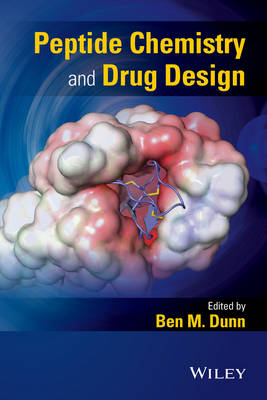
Peptide Chemistry and Drug Design
John Wiley & Sons Inc (Verlag)
978-0-470-31761-7 (ISBN)
- Titel z.Zt. nicht lieferbar
- Versandkostenfrei innerhalb Deutschlands
- Auch auf Rechnung
- Verfügbarkeit in der Filiale vor Ort prüfen
- Artikel merken
This book focuses on peptides as drugs, a growing area of pharmaceutical research and development. It helps readers solve problems of discovering, developing, producing, and delivering peptide-based drugs.
• Identifies promising new areas in peptide drug discovery
• Includes chapters on discovery from natural sources, metabolic modification, and drug delivery
• Overviews separation methods and techniques for analysis, bond formation, and purification
• Offers readers both a professional reference and a text or resource for graduate-level students
Ben Dunn is a Distinguished Professor in the Department of Biochemistry and Molecular Biology at the University of Florida. Dr. Dunn has served on many NIH review panels and is on the editorial board of Current Protocols in Protein Science. He is an author on 200 peer-reviewed publications and 4 books. Prof. Dunn has been a councillor, president-elect, president, and now past-president of the American Peptide Society.
Preface xi
List of Contributors xv
1 Peptide Therapeutics 1
Nader Fotouhi
1.1 History of Peptides as Drugs 1
1.2 Factors Limiting the Use of Peptides in the Clinic 2
1.3 Advances That Have Stimulated the Use of Peptides as Drugs 3
1.4 Development of Peptide Libraries 4
1.5 Modification of Peptides to Promote Stability and Cell Entry 6
1.6 Targeting Peptides to Specific Cells 7
1.7 Formulations to Improve Properties 7
References 8
2 Methods for the Peptide Synthesis and Analysis 11
Judit Tulla-Puche, Ayman El-Faham, Athanassios S. Galanis, Eliandre de Oliveira, Aikaterini A. Zompra, and Fernando Albericio
2.1 Introduction 11
2.2 Solid Supports 13
2.3 Linkers 15
2.4 Protecting Groups 17
2.4.1 The Special Case of Cysteine 18
2.5 Methods for Peptide Bond Formation 20
2.5.1 Peptide-Bond Formation from Carbodiimide-Mediated Reactions 20
2.5.2 Peptide-Bond Formation from Preformed Symmetric Anhydrides 22
2.5.3 Peptide-Bond Formation from Acid Halides 23
2.5.4 Peptide-Bond Formation from Phosphonium Salt-Mediated Reactions 23
2.5.5 Peptide-Bond Formation from Aminium/Uronium Salt-Mediated Reactions 24
2.6 Solid-Phase Stepwise Synthesis 26
2.6.1 Long Peptides 27
2.7 Synthesis in Solution 29
2.7.1 NProtection of the N-Terminal Amino Acid Derivative or Fragment 30
2.7.2 Carboxy-Group Protection of the C-terminal Amino-Acid Derivative or Fragment 31
2.7.3 Peptide Bond Formation 34
2.8 Hybrid Synthesis–Combination of Solid and Solution Synthesis 34
2.8.1 Classical Segment Condensation 35
2.8.2 Native Chemical Ligation 36
2.9 Cyclic Peptides 37
2.10 Depsipeptides 38
2.11 Separation and Purification of Peptides 40
2.11.1 Gel-Filtration Chromatography 41
2.11.2 Ion-Exchange Chromatography 41
2.11.3 Reverse-Phase High Performance Liquid Chromatography 42
2.12 Characterization of Peptides Through Mass Spectrometry 43
2.12.1 Ionization Source 44
2.12.2 Mass Analysers 45
2.12.3 Peptide Fragmentation 49
2.12.4 Quantification by MS 51
2.13 Conclusions 52
Acknowledgments 53
Abbreviations 53
References 56
3 Peptide Design Strategies for G-Protein Coupled Receptors (GPCRs) 75
Anamika Singh and Carrie Haskell-Luevano
3.1 Introduction 75
3.2 Classification of GPCRs 76
3.3 Catalog of Peptide-Activated G-Protein Coupled Receptors 77
3.4 Structure of GPCRs: Common Features 77
3.4.1 Crystal Structures 77
3.5 GPCR Activation 93
3.5.1 Ligand (Peptide) Binding and Receptor Activation 94
3.5.2 Common Structural Changes among GPCRs 95
3.5.3 G-Protein Coupled Intracellular Signaling Pathways 95
3.6 Structure and Function of Peptide Hormones 98
3.7 Design Approaches for GPCR Selective Peptide Ligands 98
3.7.1 Structure–Activity Relationship (SAR) Studies 99
3.7.2 Chimeric Peptide Analogs 103
3.7.3 Combinatorial Libraries 103
3.7.4 Three-Dimensional (3D) GPCR Homology Molecular Modeling 104
3.8 Conclusions 105
Acknowledgments 105
References 105
4 Peptide-Based Inhibitors of Enzymes 113
Anna Knapinska, Sabrina Amar, Trista K. Robichaud, and Gregg B. Fields
4.1 Introduction 113
4.2 Angiotensin-Converting Enzyme and Neprilysin/Neutral Endopeptidase 114
4.3 Peptide Inhibitors of the HIV-1 Viral Life Cycle 117
4.4 Matrix Metalloproteinases 118
4.5 Antrax Lethal Factor Inhibition by Defensins 125
4.6 Kinases 127
4.7 Glycosyltransferases (Oligosaccharyltransferases) 131
4.8 Telomerase Inhibitors 134
4.9 Tyrosinase 138
4.10 Peptidyl-Prolyl Isomerase 140
4.11 Histone Modifying Enzymes 143
4.11.1 Histone Deacetylase 144
4.11.2 Histone Methyl-Transferase 145
4.12 Putting it all Together: Peptide Inhibitor Applications in Skin Care 146
4.13 Strategies for the Discovery of Novel Peptide Inhibitors 147
Acknowledgments 148
References 148
5 Discovery of Peptide Drugs as Enzyme Inhibitors and Activators 157
Jeffrey-Tri Nguyen and Yoshiaki Kiso
5.1 Introduction 157
5.1.1 Peptide Residue Nomenclature 158
5.1.2 Common Methods of Drug Design 159
5.1.3 Phases of Drug Development 163
5.2 Enzyme Types That Process Peptides 164
5.2.1 Enzymes as Chemicals in Consumer and Medical Products 164
5.2.2 Nonspecific Enzyme Inhibitors 166
5.3 Amino Acid Drugs 166
5.3.1 Thyroid Hormones 166
5.3.2 An Ornithine Decarboxylase Inhibitor 167
5.3.3 Catecholamines 168
5.4 Serine Proteases and Blood Clotting 169
5.4.1 Blood Coagulating Agents 170
5.4.2 Enzymes as Blood Anticoagulants 171
5.4.3 Direct Thrombin Inhibitors as Blood Anticoagulants 171
5.5 Diabetes Mellitus 174
5.5.1 Peptide Hormones and Blood Glucose Regulation 174
5.5.2 Glucagon-Like Peptide-1 and Analogs 175
5.5.3 Dipeptidyl Peptidase-4 Inhibitors 176
5.6 Renin–Angiotensin–Aldosterone System 178
5.6.1 ACE Inhibitors 178
5.6.2 Renin Inhibitors 180
5.7 Penicillin and Cephalosporin Antibiotics 183
5.8 HIV Protease 184
5.8.1 HIV-Specific Protease Inhibitors 185
5.9 Peptide Drugs Under Development 188
5.9.1 Cathepsins 188
5.9.2 Cysteine Proteases 189
5.9.3 Secretases in Alzheimer’s Disease 189
5.9.4 Trypsin-Like Serine Proteases 190
5.9.5 Zinc Metalloproteases 190
5.9.6 Non-mammalian Proteases 191
5.10 Discussion 192
Acknowledgments 193
References 193
6 Discovery of Peptide Drugs from Natural Sources 203
Sónia T. Henriques and David J. Craik
6.1 Introduction 203
6.2 Peptides are Involved in the Host Defense Mechanism of Living Organisms 206
6.2.1 Cationic AMPs from Eukaryotes Peptides that Target the Membrane 207
6.2.2 Peptides and the Host Defense in Bacteria – Bacteriocins 211
6.2.3 Cyclotides Ultra-Stable Peptides that are Part of Plant Defense Mechanism 216
6.3 Animal Venoms a Rich Source of Peptides with Therapeutic Potential 219
6.3.1 Conotoxins a Naturally Occurring Combinatorial Peptide Library 219
6.4 Optimization of Peptides for Drug Development 224
6.4.1 Chemical Modifications to Improve Activity 224
6.5 Conclusions 227
Acknowledgments 227
References 227
7 Modification of Peptides to Limit Metabolism 247
Isuru R. Kumarasinghe and Victor J. Hruby
7.1 Introduction 247
7.2 Introduction of Unnatural Amino Acids 248
7.3 Cyclization of Linear Peptides to Improve Stability Toward Blood and Brain Protease Degradation 249
7.4 Introduction of D-Amino Acids into Peptides Improves Stability Toward Blood and Brain Protease Degradation 253
7.5 Introduction of β-Amino Acids Increases the Stability Toward Blood and Brain Protease Degradation 254
7.6 Introduction of Peptide Bond Isosteres 255
7.7 Introduction of a N-Methylation of the Amide Bond of Peptides Can Improve the Stability Toward Blood and Brain Protease Degradation 258
7.8 Use of Unnatural Amino Acids – Use of Topographically Constrained Amino Acid 260
7.9 Using Glycosylated Amino Acids to Increase the Resistance of the Proteolytic Degradation 261
7.10 Creation of Peptides as Multiple Antigen Peptide (MAP) Dendrimeric Forms Increases the Stability Toward Blood and Brain Protease Degradation 262
7.11 Halogenations of Aromatic Residues in Peptides Can Reduce the Enzymatic Recognition Required for Peptide Hydrolysis 263
7.12 Concluding Discussion 264
References 265
8 Delivery of Peptide Drugs 271
Jeffrey-Tri Nguyen and Yoshiaki Kiso
8.1 Introduction 271
8.2 Lipinski’s Rule of Five 271
8.2.1 Molecular Size 272
8.2.2 Lipophilicity 274
8.2.3 Chemical Stability 278
8.2.4 Routes of Administration 282
8.3 Approaches to Delivering Peptide Drugs 282
8.3.1 Enzyme Inhibitors 283
8.3.2 Permeation Enhancers 284
8.3.3 Delivery of Peptide Drugs across the Blood–Brain Barrier 286
8.4 Parenteral Peptide Drugs 290
8.5 Topical Peptide Drugs for Local Effects 294
8.5.1 Cosmeceutical Peptides 294
8.6 Intranasal Peptide Drug Delivery 295
8.7 Enteral Peptide Drugs 297
8.8 Different Routes of Administration for Insulin 299
8.9 Discussion 300
Acknowledgments 301
References 301
Index 311
| Erscheint lt. Verlag | 24.4.2015 |
|---|---|
| Verlagsort | New York |
| Sprache | englisch |
| Maße | 163 x 244 mm |
| Gewicht | 585 g |
| Themenwelt | Naturwissenschaften ► Biologie |
| Naturwissenschaften ► Chemie | |
| ISBN-10 | 0-470-31761-2 / 0470317612 |
| ISBN-13 | 978-0-470-31761-7 / 9780470317617 |
| Zustand | Neuware |
| Haben Sie eine Frage zum Produkt? |
aus dem Bereich


